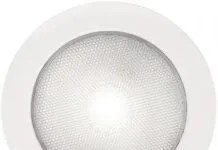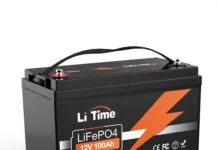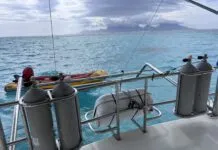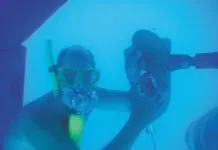
The dawn of the fiberglass era transformed the boatbuilding industry, making sailing more accessible and affordable. With fiberglass’s strength, low maintenance and adaptability, boat ownership soared as boats were mass-produced and “popped” out of molds. However, the ecological consequences of glass-reinforced plastic (GRP) are now impossible to ignore. The growing problem of end-of-life GRP boats—derelict vessels abandoned in marinas and littering coastlines—poses significant threats to marine ecosystems and, increasingly, to human health.
As we considered what vessel would be ideal for our Floating Stories Lab—a regenerative futures research and storytelling sailboat studio—the process became just as important as the end product. We landed on self building a Wharram Designs Narai Mk IV wooden catamaran not only for its design and functionality, but because we wanted to focus attention on the art of boatbuilding itself—crafting something with our hands, sourcing and selecting materials, and taking accountability for how our actions impact the ecosystems we exist within.
We’re not alone; some of the biggest names in boatbuilding are exploring alternatives to mass-produced GRP. But can a revival in wooden boatbuilding lead the industry on a more regenerative tack, or are we simply exchanging one set of environmental challenges for another? Moreover, how much greenwashing is really out there, and does the avoidance of transparency hinder progress towards more regenerative practices in the boatbuilding industry?
Before we order the timber, sheets of ply and barrels of epoxy required to build our wooden cat, we wanted to learn much more about the legacy of these materials that make up modern wooden boat builds like ours.
Caveat: Boatbuilding is not a static practice; it’s constantly changing and innovating, whilst also nodding to the past for lessons and inspiration. I reserve the right to continue being curious, learning and changing my mind.
WHAT IS REGENERATION?
Regenerative practices move beyond sustainability, or “doing less bad,” by striving for a net positive impact. In the case of boatbuilding, we can think of regeneration as integrating ecological, social and cultural dimensions to foster practices that contribute to thriving environments while leveraging local materials and community participation.
With that in mind, let’s step back in time…
TIMBER IN ANCIENT BOATBUILDING
The use of timber in boatbuilding has a fascinating history, though it likely wasn’t the first material used by our seafaring ancestors in building watercraft. Prehistoric humans constructed vessels from reeds, animal skins and hollowed-out logs long before the advent of more sophisticated timber constructions.
Dugout canoes are among the earliest known wooden watercraft, with archaeological finds dating back more than 7,000 years in regions like the Netherlands and Nigeria (Vaucher, 2014.). Made from hollowed tree trunks, these vessels were essential for early riverine and coastal transport, laying the foundation for more complex wooden boat designs.
TRADITIONAL TIMBER TYPES AND CONSTRUCTION TECHNIQUES BY REGION
When it comes to wooden vessels, boatbuilders across the world have historically relied on locally available timber to construct their boats, with their choices shaped by the physical properties of the wood, spiritual beliefs and the marine environments they navigated. The selection of timber was crucial for its practical qualities—durability, flexibility and resistance to decay—but also its cultural and spiritual significance. Many societies saw the felling of trees for boatbuilding as a sacred act and often accompanied the practice with rituals that reflected their deep connection to the land and sea. Construction techniques were similarly influenced by these factors, with unique methods evolving in different regions to optimize the use of local resources and ensure the vessels could withstand the challenges of their respective waters.
Some notable examples of timber types and construction techniques across different regions include:
Northern Europe

Viking longships, built during the Viking Age (circa 800-1100 AD), were primarily constructed from oak, a strong and flexible wood. These vessels were built using a clinker (lapstrake) method of construction, where the planks of the ship overlapped each other along their edges. The overlapping planks were fastened together using a combination of iron rivets (often referred to as nails) and roves, which were small iron washers placed on the inside of the ship to secure the rivets and hold the planks in place. The rivets would be hammered through the overlapping planks from the outside, with the roves fitted on the inside, and the end of the rivet would be peened over to secure the fastening. This method provided the ships with durability and flexibility—crucial for navigating the rough seas of the North Atlantic (McGrail, 2004; Royal Museums Greenwich, n.d.).
Mediterranean
Ancient Egyptian ships, such as Pharaoh Khufu’s solar barque, were likely constructed from imported Lebanese cedar, a wood valued for its resistance to decay. While reed boats like the Ra were among Egypt’s earliest watercraft, timber ships soon dominated as more complex construction techniques evolved to navigate the Nile and the Mediterranean (Casson, 1995; Tyson, 2009). The Egyptians employed a “shell-first” method, assembling hull planks edge-to-edge with wooden pegs and rope lashings. Reeds and grasses were used to seal seams for watertightness. Notably, Khufu’s boat lacked metal fasteners; instead, mortise-and-tenon joints and ropes, threaded through holes and tied, held the hull together. This flexible yet sturdy design could endure the pressures of both river and coastal voyages (Tyson, 2009).
Pacific Islands

In the Pacific, boatbuilders utilized lightweight, buoyant woods such as breadfruit and coconut palm, which were abundant and well-suited for constructing ocean-going vessels. Polynesian double-hulled canoes, known as vakas or wa’a, were the epitome of Polynesian maritime technology, designed specifically for long-distance voyages across vast expanses of the Pacific Ocean. The natural buoyancy of these timbers, combined with their durability, allowed the canoes to remain stable even in rough seas, while their relatively light weight contributed to faster speeds and more efficient travel. These double-hulled vessels, with their innovative outrigger designs, were crucial in the successful navigation and colonization of the remote Pacific islands. The canoes were often lashed together with ropes made from coconut fiber, which added to their flexibility and ability to withstand the stresses of long voyages (Thompson, 2019).
In addition to practical benefits, Polynesian boatbuilding was deeply intertwined with spiritual practices. The selection of timber was often a ceremonial process, with specific trees considered sacred and carefully chosen for boat construction. The building of a vessel was not just a technical endeavor but also a cultural one, where connection to the land, sea and ancestors played a central role (Thompson, 2019).
TRANSITION TO PLYWOOD IN BOATBUILDING
As timber became increasingly scarce and costly, particularly in industrialized regions, boatbuilders turned to alternative materials to meet the growing demand for durable and affordable vessels. Plywood, a composite wood material created by gluing together thin layers of wood veneer at alternating angles, gained traction as a commercial product in the early 20th century, with Emanuel Nobel, cousin of Alfred Nobel (of Nobel Prize fame), often credited with filing one of the earliest patents for laminated wood panels in 1885. However, it was not until the 1920s and 1930s that technological advancements in glue formulations, combined with growing demand for strong, lightweight materials, led to the widespread commercial production of plywood. By World War II, when resources were limited, plywood had become a crucial material in the construction of military boats, airplanes and other essential war machinery due to its versatility and ease of mass production (Crawford, 1999).
ADVANTAGES FOR BOATBUILDERS

James Wharram’s revolutionary “backbone and bulkheads” method uses the boat’s own structure as the guide, for a drastic reduction of pieces of wood, measurement and saw cuts to reach the final ply planking stage. With the classic designs, there were no metal fixings, just glue—urea-formaldehyde at first, then resorcinol, and today, epoxy. (Photo/ Craig Kuhn/ Wharram Designs)
The transition to plywood offered several key advantages for boatbuilders. First, its cross-laminated structure provided increased resistance to dimensional changes caused by moisture. Unlike solid wood, which can warp or swell when exposed to water, plywood maintained its shape and strength over time (Tucker, 2012). The uniformity and large size of plywood sheets also allowed boatbuilders to create smooth, continuous surfaces, reducing the number of seams and joints where water could potentially penetrate the hull.
Additionally, plywood’s manufacturing process made it more affordable and widely available than large planks of timber, which became increasingly scarce and expensive due to deforestation and overharvesting. Plywood could be made from smaller, “less valuable trees,” which producers argued would conserve precious timber resources. Thus the combination of strength, affordability and availability made plywood an attractive option for the growing recreational boating market. Indeed, its rise in popularity was further fueled by the increasing number of amateur boatbuilders after the war, who valued its ease of use and relatively simple construction techniques. For small boatbuilders and hobbyists alike, plywood presented an opportunity to create functional, long-lasting vessels without requiring advanced woodworking skills (Wharram, 2020).
HOW IS PLYWOOD MADE?
The process of making plywood involves cutting thin layers or “veneers” of wood from a log using a rotary lathe, where the log is turned against a sharp blade to peel off continuous sheets of veneer. These sheets are then dried, trimmed, and sorted by quality. The key innovation in plywood production lies in the orientation of these veneers: each sheet is placed at a right angle to the one below it, with the grains running perpendicular to one another. This cross-lamination process results in increased structural strength and improved dimensional stability of the plywood compared to solid wood (Tucker, 2012).
After the veneers are layered in alternating directions, they are bonded together using adhesives—traditionally urea-formaldehyde or phenol-formaldehyde resins, which are water-resistant and capable of withstanding marine environments. The layers are then compressed under high pressure and heat to cure the glue, resulting in a strong, flat panel that can resist warping, cracking, and splitting (Bass, 2005). This process not only creates a material that is stronger than the sum of its parts but also allows plywood to be manufactured in large, uniform sheets, ideal for boatbuilding.
However, this process has significant downsides. The production of plywood consumes large amounts of energy, particularly in drying the veneers and applying high-pressure compression to bond the layers, whilst the use of synthetic adhesives introduces additional environmental concerns and make plywood difficult to recycle at the end of its life cycle. The large-scale industrial logging practices required to source the raw timber for veneer production also contribute to deforestation, loss of biodiversity and carbon emissions, especially if the timber is not sustainably harvested (Paddison, 2021).
SOURCING AND SUPPLY CHAINS

As marine plywood and hardwoods grew in demand during the mid-20th century, deforestation became a major issue, particularly in tropical regions where hardwoods like okoumé, teak and mahogany were harvested. While the construction industry was the largest driver of this deforestation, the marine industry also contributed by seeking durable, water-resistant timber for boatbuilding. Logging in these regions led to widespread habitat destruction, soil degradation, loss of biodiversity and significant carbon emissions (Crawford, 1999).
At the time, there was little concern about sustainable forestry, and large-scale industrial logging was conducted with minimal regard for long-term environmental impacts. The surge in demand for marine plywood after World War II, especially for tropical hardwoods, further exacerbated the problem, leaving vulnerable ecosystems at risk. This deforestation had social consequences as well, displacing indigenous communities and leading to conflicts over land rights.
The establishment of certification systems like the Forest Stewardship Council (FSC) in the 1990s aimed to mitigate these impacts by promoting sustainable forest management. FSC and other certifications, such as the Programme for the Endorsement of Forest Certification (PEFC), were designed to ensure that timber was harvested responsibly, protecting forests from over-exploitation while promoting biodiversity and regeneration. However, investigations, such as those conducted by Yale Environment 360, revealed that even FSC-certified operations were sometimes linked to illegal logging and deforestation, undermining the credibility of these certifications (Paddison, 2021).
COMPANIES WHO ARE SETTING THE NEW STANDARD
For boatbuilders committed to regeneration, sourcing certified timber is necessary, but it does not guarantee minimal environmental or social impact. Timber sourcing thus requires a continuous monitoring of supply chains to ensure ethical practices.
Companies like Spirit Yachts are setting an example by sourcing sustainable woods and donating timber offcuts to local woodworking programs (Stocker, 2024), whilst Blue Tree Boat Builders have taken a further step by establishing a dedicated Research Lab. This lab explores best practices in material sourcing, process optimization and life-cycle analysis, all within a cradle-to-cradle framework that aligns with wider environmental policies. Their Project Harmony initiative focuses on integrating sustainability into every aspect of boatbuilding—from procurement and build processes to after-care—while openly sharing life cycle analysis (LCA) results with the aim of continuously improving industry standards and educating future generations.
Finnish company Vendia Woods uses slow-grown pine, harvested with long-term forest regeneration in mind. By limiting transportation emissions and employing waste-minimizing production techniques, Vendia demonstrates how localized, responsible timber management can help reduce the ecological footprint of marine plywood production.
PLYWOOD FOR BOATBUILDING: TYPES AND CONSIDERATIONS

Plywood revolutionized boatbuilding with its versatility, stability and lightweight properties. There are three main types of plywood used in marine applications:
- Moisture Resistant (MR)
- Weather and Boil Proof (WBP)
- Boil Resistant (BR)
For boatbuilding, WBP plywood is the obvious choice due to its water resistance and stability. However, the type of glue used in manufacturing is critical, as it directly affects the plywood’s durability in marine conditions. It is essential to choose plywood that conforms to BS 1088 marine standards to ensure it meets the necessary durability and performance criteria for use in marine environments (Greenwell, 1995).
Several types of marine-grade plywood are commonly used today, each offering distinct advantages and challenges:
Okoumé Plywood (BS 1088 Certified)
-
- Pros: Okoumé is highly prized for its lightweight, flexible nature, making it perfect for stitch-and-glue and lightweight designs. It is easy to work with and has a smooth surface, ideal for epoxy coating.
- Cons: Okoumé lacks natural rot resistance, meaning it must be sealed with epoxy or protective coatings to withstand marine environments.
- Eco and Social Challenges: Primarily harvested from Gabon and West Africa, Okoumé is often sourced from regions facing severe deforestation, illegal logging, and biodiversity loss. While FSC-certified Okoumé is available, the social challenges, including the displacement of indigenous communities, continue to pose significant issues (Paddison, 2021; Greenwell, 1995).
Meranti Plywood
-
- Pros: Meranti is stronger and more rot-resistant than Okoumé, making it ideal for structural parts of a boat, such as bulkheads and hulls. It is also relatively affordable and offers good stability.
- Cons: Heavier and less flexible than Okoumé, Meranti can be harder to work with and requires protective coatings for long-term water resistance.
- Eco and Social Challenges: Sourced primarily from Southeast Asia, Meranti plywood faces the same ecological issues as other tropical hardwoods, including deforestation and habitat loss. In addition to environmental concerns, indigenous peoples in these regions often face displacement and exploitation (Greenwell, 1995).
Douglas Fir Plywood
-
- Pros: Douglas fir is a durable and rot-resistant softwood option widely available in North America, with non-native fir also grown across Europe, predominately in France. If well selected, it can be used for decking and has also been used with epoxy and glass sheathing on hulls and structural components.
- Cons: Moderately durable, stiff and less elastic, Douglas fir is harder to bend, which may limit its use for intricate designs or lightweight applications.
- Eco and Social Challenges: Though it is more sustainably sourced than tropical hardwoods, Douglas fir logging contributes to habitat loss and ecosystem degradation. Responsible forestry management is necessary to reduce its environmental impact (Greenwell, 1995).
Baltic Pine Plywood
-
- Pros: Baltic pine is a durable and cost-effective softwood native to the Baltic region. It offers good workability and a fine grain and is relatively lightweight.
- Cons: Baltic pine is less rot-resistant than other softwoods like Douglas fir and may require treatment for long-term durability in humid or marine environments. Its availability can also fluctuate, leading to inconsistent quality and pricing outside its native regions.
- Eco and Social Challenges: Baltic pine is generally more sustainably harvested than tropical hardwoods. However, large-scale logging in northern Europe has raised concerns about biodiversity loss and soil depletion.
Mahogany Plywood
-
- Pros: Mahogany plywood is prized for its beautiful finish and natural durability, particularly for decorative parts of boats. It has high strength and is rot-resistant when properly sealed, making it ideal for hulls and decks.
- Cons: Mahogany is heavy and relatively expensive, and it requires proper sealing to withstand water exposure.
- Eco and Social Challenges: Harvested primarily from Central and South America, mahogany is subject to overharvesting and illegal logging. The social impact of its sourcing includes the displacement of local communities and the destruction of ecosystems vital to indigenous livelihoods (Greenwell, 1995).
Exterior Grade Plywood (WBP Certified)
-
- Pros: Birch and other exterior-grade plywoods are available for less critical applications. These are often used for components like rudder blades and daggerboards due to their affordability and stability when coated properly.
- Cons: Birch plywood is less durable for direct marine exposure unless properly protected.
- Eco and Social Challenges: Sourcing birch and other exterior-grade plywood still involves concerns about deforestation, particularly when it is not sourced from certified sustainable forestry operations (Greenwell, 1995).
HARDWOODS FOR BOATBUILDING
In addition to marine plywood, boatbuilders frequently turn to solid hardwoods for critical components like decking, hulls and trim. Common hardwoods include:
Teak
-
- Pros: Famous for its natural durability, rot resistance and strength, teak is a top choice for boat decks and other high-exposure areas. It can withstand harsh marine conditions and is long-lasting.
- Cons: Teak is extremely expensive and difficult to source ethically due to overharvesting and political instability in teak-producing regions.
- Eco and Social Challenges: Teak is mostly harvested from Myanmar and other Southeast Asian regions, where illegal logging and deforestation are rampant. The political and social issues in these regions further exacerbate the challenges of sourcing teak responsibly. Plantation-grown FSC-certified teak is available, but it comes at a high price (Greenwell, 1995).
Iroko
-
- Pros: Known as “African teak,” Iroko offers durability and rot resistance at a lower price than traditional teak. It is suitable for decking and other high-stress areas.
- Cons: Iroko can be challenging to work with due to its dense grain.
- Eco and Social Challenges: Harvested from West and Central Africa, Iroko presents similar environmental and social challenges to other tropical hardwoods, including deforestation and illegal logging. Like teak, it is essential to source FSC-certified Iroko to ensure sustainability (Greenwell, 1995).
Western Red Cedar
-
- Pros: This softwood is lightweight and naturally rot-resistant, making it ideal for strip-planked boats. Its natural oils offer additional protection against decay, reducing the need for chemical treatments.
- Cons: Western red cedar is softer than other hardwoods, making it more prone to surface damage, though it is useful where lightness is required.
- Eco and Social Challenges: Sourced from the Pacific Northwest, western red cedar faces ecological challenges due to clear-cutting practices that lead to habitat loss and ecosystem degradation. Indigenous communities in these regions are often affected by the logging industry, which impacts their access to traditional lands (Greenwell, 1995).
LOCAL SOURCING AND SALVAGED WOOD
Local wood sourcing offers a way to reduce the carbon footprint associated with long-distance transport. Companies like RM Yachts, which sources wood within an 80-mile radius, provide a model for how boatbuilders can lower their environmental impact while supporting local economies (Dohy, 2023).
In addition to sourcing locally, the use of reclaimed or salvaged timber is gaining popularity as a way to reduce the demand for freshly harvested wood. Reclaimed wood from decommissioned boats, buildings or other structures can be repurposed for new boat construction, reducing the need for deforestation and aligning with regenerative principles by giving valuable materials a second life (Kibert, 2016). French association La Matiere collects timber and plywood scrap, seconds and offcuts, repurposing them for sale to the public at a significant discount. They also offer circular DIY workshops, are developing sustainable living spaces with a focus on the resuse of materials, whilst training and educating businesses, communities and citizens about the challenges of the circular economy and sustainable development.
CONCLUSIONS
As we continue this tip toe into a revival of wooden boatbuilding, exploring the legacies and evolution of materials, it’s clear already that while timber and plywood offer more sustainable alternatives to GRP, their sourcing and environmental impact must be carefully considered. Certifications such as FSC can help guide responsible timber choices, but challenges remain in ensuring that these materials are harvested and used in ways that align with regenerative practices.
REFERENCES
Casson, L. (1995). Ships and seamanship in the ancient world. The Johns Hopkins University Press.
Crawford, R. (1999). The post-war transformation of boatbuilding: Plywood’s rise in the marine industry. Historical Boatbuilding Journal, 15(3), 200–215.
Greenwell, D. (1995, June). Guide to plywood. Practical Boat Owner.
McGrail, S. (2004). Boats of the world: From the Stone Age to medieval times. Oxford University Press.
Paddison, L. (2021). Greenwashed timber: How ‘sustainable’ forest certification has failed. Yale Environment 360. Retrieved from https://e360.yale.edu/features/greenwashed-timber-how-sustainable-forest-certification-has-failed
Royal Museums Greenwich. (n.d.). Viking ships. Royal Museums Greenwich. https://www.rmg.co.uk/stories/topics/viking-ships
Stocker, T. (2024). Are wooden boats the answer to environmentally responsible yachting? Yachting Monthly.
Thompson, C. (2019). Sea people: The puzzle of Polynesia. Harper.
Tucker, A. M. (2012). Advances in marine composite materials. Woodhead Publishing.
Tyson, P. (2009). The pharaoh’s ship. NOVA, PBS. Retrieved from https://www.pbs.org/wgbh/nova/pharaoh/expl-nf.html
Vendia Story. (2024). From the forest to the sea. Retrieved from Vendia Woods documentation.
Vaucher, J. (n.d.). Prehistoric craft: The origin of ships. Retrieved from History of Ships website.
Wharram, J. (2020). Lessons from the Stone Age sailors: The legacy of plywood in catamaran design. Wharram.com. Retrieved from https://www.wharram.com/articles/lessons-from-the-stone-age-sailors

































No thanks. “No wood on my boat” has been my motto for years and I’m not going back.
Yes, GRP relies on chemistry but so does wood protection. I suppose we could go back to tar instead though. At the end of a fiberglass boat , grind it up and mix it with road building materials and concrete structures instead of steel bars.